Related Research Articles

Lowell is a city in Massachusetts, United States. Alongside Cambridge, it is one of two traditional seats of Middlesex County. With an estimated population of 115,554 in 2020, it was the fifth most populous city in Massachusetts as of the last census, and the third most populous in the Boston metropolitan statistical area. The city is also part of a smaller Massachusetts statistical area, called Greater Lowell, and of New England's Merrimack Valley region.
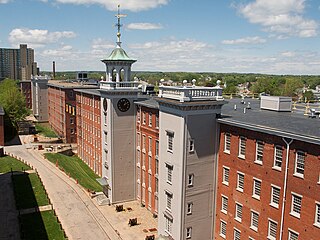
Lowell National Historical Park is a National Historical Park of the United States located in Lowell, Massachusetts. Established in 1978 a few years after Lowell Heritage State Park, it is operated by the National Park Service and comprises a group of different sites in and around the city of Lowell related to the era of textile manufacturing in the city during the Industrial Revolution. In 2019, the park was included as Massachusetts' representative in the America the Beautiful Quarters series.
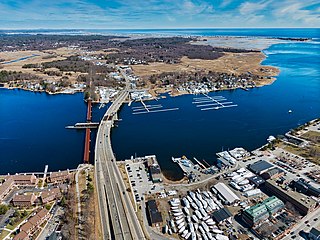
The Merrimack River is a 117-mile-long (188 km) river in the northeastern United States. It rises at the confluence of the Pemigewasset and Winnipesaukee rivers in Franklin, New Hampshire, flows southward into Massachusetts, and then flows northeast until it empties into the Gulf of Maine at Newburyport. From Pawtucket Falls in Lowell, Massachusetts, onward, the Massachusetts–New Hampshire border is roughly calculated as the line three miles north of the river.

Francis Cabot Lowell was an American businessman for whom the city of Lowell, Massachusetts, is named. He was instrumental in bringing the Industrial Revolution to the United States.

George Washington Whistler was a prominent American civil engineer best known for building steam locomotives and railroads. He is credited with introducing the steam whistle to American locomotives.

The Middlesex Canal was a 27-mile (44-kilometer) barge canal connecting the Merrimack River with the port of Boston. When operational it was 30 feet wide, and 3 feet deep, with 20 locks, each 80 feet long and between 10 and 11 feet wide. It also had eight aqueducts.

Completed in 1796, the Pawtucket Canal was originally built as a transportation canal to circumvent the Pawtucket Falls of the Merrimack River in East Chelmsford, Massachusetts. In the early 1820s it became a major component of the Lowell power canal system. with the founding of the textile industry at what became Lowell.
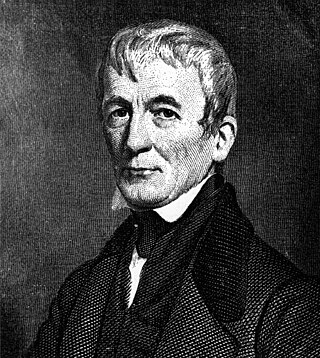
Patrick Tracy Jackson was an American manufacturer, one of the founders of the Boston Manufacturing Company of Waltham, Massachusetts, and later a founder of the Merrimack Manufacturing Company, whose developments formed the nucleus of Lowell, Massachusetts.

The Merrimack Canal is a power canal in Lowell, Massachusetts. The canal, dug in the 1820s, begins at the Pawtucket Canal just above Swamp Locks, and empties into the Merrimack River near the Boott Cotton Mills. The Merrimack Canal was the first major canal to be dug at Lowell exclusively for power purposes, and delivered 32 feet (9.8 m) of hydraulic head to the mills of the Merrimack Manufacturing Company. The Merrimack Manufacturing Company was the first of the major textile mills constructed in Lowell. It was demolished around 1960.
The history of Lowell, Massachusetts, is closely tied to its location along the Pawtucket Falls of the Merrimack River, from being an important fishing ground for the Pennacook tribe to providing water power for the factories that formed the basis of the city's economy for a century. The city of Lowell was started in the 1820s as a money-making venture and social project referred to as "The Lowell Experiment", and quickly became the United States' largest textile center. However, within approximately a century, the decline and collapse of that industry in New England placed the city into a deep recession. Lowell's "rebirth", partially tied to Lowell National Historical Park, has made it a model for other former industrial towns, although the city continues to struggle with deindustrialization and suburbanization.

Kirk Boott was an American industrialist who was instrumental in the early history of Lowell, Massachusetts.

The Lowell Power Canal System is the largest power canal system in the United States, at 5.6 miles in length. It is operating through six major canals on two levels, controlled by numerous gates. The system was begun in the 1790s, beginning its life as a transportation canal called the Pawtucket Canal, which was constructed to get logs from New Hampshire down the Merrimack River to shipbuilding centers at Newburyport, Massachusetts, bypassing the 30-plus-foot drop of the Pawtucket Falls.
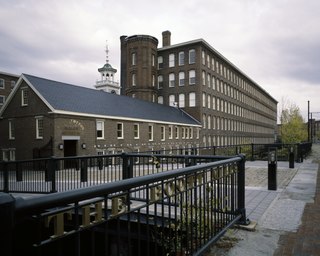
The Boott Mills in Lowell, Massachusetts were a part of an extensive group of cotton mills, built in 1835 alongside a power canal system in this important cotton town. Its incorporators were Abbott Lawrence, Nathan Appleton, and John Amory Lowell, and is named after Kirk Boott, the first Agent of the Proprietors of Locks & Canals in Lowell. Today, the Boott Mills complex is the most complete remainder of antebellum textile mills built in Lowell. The original Mill No. 6 is managed by the National Park Service unit Lowell National Historical Park and houses the Boott Cotton Mills Museum and the Tsongas Industrial History Center for K-12 educational programs.
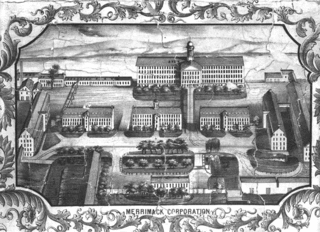
The Merrimack Manufacturing Company was the first of the major textile manufacturing concerns to open in Lowell, Massachusetts, beginning operations in 1823.

The Merrimack Valley is a bi-state region along the Merrimack River in the U.S. states of New Hampshire and Massachusetts. The Merrimack is one of the larger waterways in New England and has helped to define the livelihood and culture of those living along it for millennia.

The Saco-Lowell Shops was once one of the largest textile machine manufacturers in the United States. It was formed in 1912 with a merger between the Lowell Machine Shop with the Saco-Pettee Machine Company. At its peak in the 1920s, the company had manufacturing facilities in Lowell and Newton, Massachusetts, and Biddeford, Maine. The company maintained their executive office at 77 Franklin Street in Boston, and also had a southern office in Charlotte, North Carolina.
The following is a timeline of the history of Lowell, Massachusetts, US.
Hugh Cummiskey was a leader of the early Irish community in Lowell, Massachusetts in the United States.

Pawtucketville is a neighborhood and village within the city of Lowell, Massachusetts.
References
- ↑ "Towpath Topics - November 1967". Middlesexcanal.org. Retrieved 2013-05-25.
- ↑ "An Act incorporating Dudley Atkins Tyng, Esq. and others, for the Purpose of rendering Merrimack River passable etc.", June 27, 1792, p. 382ff, in Private and Special Statutes of the Commonwealth of Massachusetts from the year 1780 etc., 1, 1805.
- ↑ ASME Landmark report Archived 2011-08-16 at the Wayback Machine
- ↑ "Lowell Notes: Patrick Tracy Jackson" (PDF). National Park Service. Lowell National Historical Park . Retrieved 27 January 2018.
- ↑ "University of Massachusetts Lowell Center Lowell History". library.uml.edu. Retrieved 2015-12-11.
- ↑ Proceedings of the American Society of Civil Engineers, 1918, Volume 45, Part 1, page 369, "James Hayward Harlow Obituary." Accessed at Google Books on June 4, 2024
- ↑ "Burnettizing. Award". Digital Commonwealth. University of Massachusetts Lowell, Center for Lowell History.